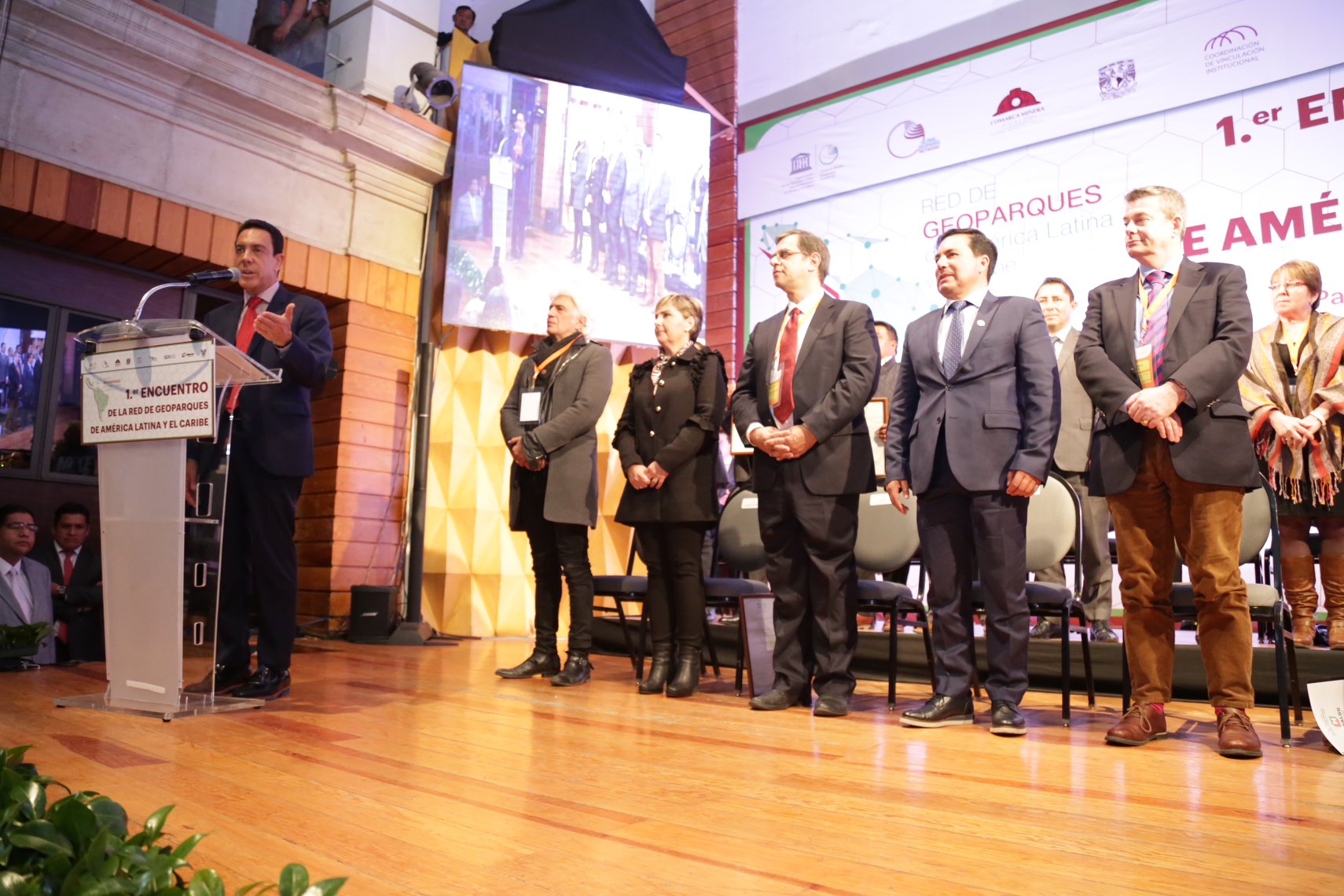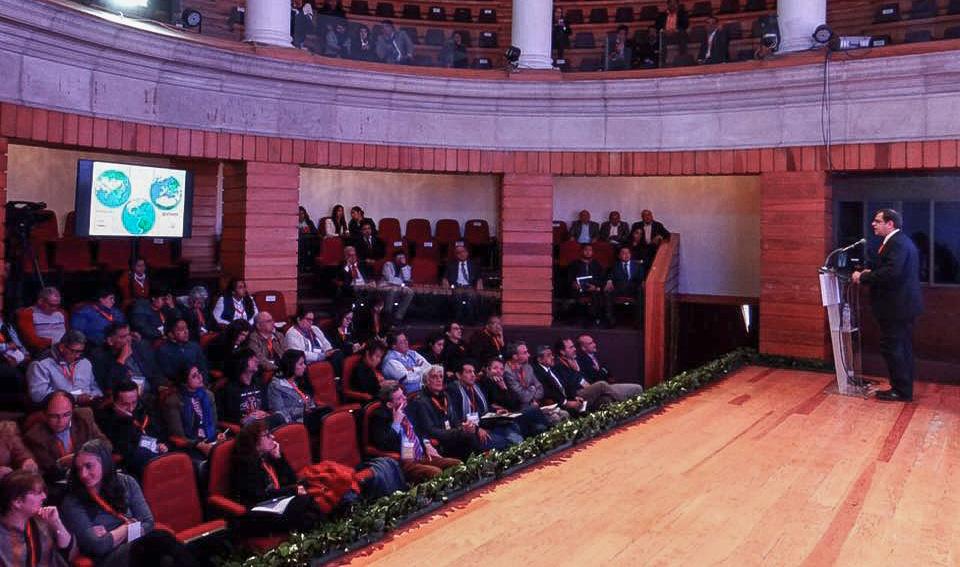1st Meeting of the Latin America and Caribbean Geoparks Network - GEO-LAC
The 1st Latin America and Caribbean Geoparks Meeting took place in Comarca Minera Hidalgo in Mexico 21-25 January 2018. Parallel to the Coordination Committee Meeting, open sessions were organized with the participation of the representatives of the 4 Latin American and Caribbean UNESCO Global Geoparks, UNESCO, GGN, the two Canadian UNESCO Global Geoparks and aspiring Geoparks from Peru, Bolivia, Ecuador, Colombia. 
The Governor of Hidalgo State Omar Fayad accompanied by the Secretary of Tourism of Hidalgo State Eduardo Javier Baños Gomez and the representative of the University of Mexico - UNAM at the awarding ceremony with the Mayors of the 9 municipalities of the Comarca Minera UNESCO Global Geopark. The first open session was dedicated to the official celebration of the recognition of Comarca Minera Hidalgo as UNESCO Global Geopark with the participation of the Governor of Hidalgo State Omar Fayad , the Secretary of Tourism of Hidalgo State Eduardo Javier Baños Gomez and all the Mayors of the Geopark communities. Other open sessions included presentations of best practice from the participating UNESCO Global Geoparks in Latin America, their geoheritage and geotourism resourses, and the common activities of the Latin America and Caribbean Geoparks Network. The Meeting included field trips to the impressive geosites of the Comarca Minera Hidalgo UNESCO Global Geopark.

The Governor of Hidalgo State Omar Fayad delivering a speech at the opening of the 1st Latin Americal and Caribbean Geoparks Network Meeting in Pachuca, Hidalgo State, Mexico on January 21st, 2018. The ceremony attended Patrick MacKeever, Chief of Section Earth Sciences and Geo-hazards Risk Reduction UNESCO, the Secretary of Tourism of Hidalgo State Eduardo Javier Baños Gomez, Prof. Nickolaos Zouros President of the Global Geoparks Network and Guy Martini UNESCO Global Geoparks Council Chair. Operational Guidelines of Geo-LAC The first Coordination Committee Meeting of the Latin America and Caribbean Geoparks Network, took place on January 22 – 25, 2018. the representatives of the four UNESCO Global Geoparks in the region: Patricio Melo from Araripe – Brazil, Diego Irazabal and Cezar Gozo from Grutas del Palacio – Uruguay, Carles Canet Miquel from Comarca Minera Hidalgo and José Luis Palacio Prieto from Mixteca Alta from Mexico, together with the head of the UNESCO Global Geopark Secretariat Patrick MacKeever, the GGN President Nickolas Zouros, the GGN Secretary General Guy Martini, the representative of the UNESCO Montevideo office Denice Gorfinkiel with the presence of the representatives of the two Canadian UNESCO Global Geoparks Jane Fullerton from Stonehammer UGGp and Sarah Waters Tumbler Ridge UGGp met to discuss the structure, operation and activities of the Latin America and Caribbean Geoparks Network as well as their cooperation with the Canadian UGGps.The four members of the Latin America and Caribbean Geoparks Network agreed on the Operational Guidelines of the Geo-LAC and elect the Coordinators and other officials. Latin America and Caribbean Geoparks Network Elections During the meeting the representatives of the four Latin America and Caribbean Geoparks elected the first coordinators of the Latin America and Caribbean Geoparks Network. The following colleagues were elected:
- Coordinator : Carlos Canet Miquel, Comarca Minera UGG, Mexico
- Vice Coordinator: Patricio Melo, Araripe UGG, Brazil
- Secretary: Diego Irazabal , Grutas Del Palacio UGG, Uruguay
- Treasurer: Jose Luis Palacio, Mixteca Alta UGG, Mexico

The representatives of the four UNESCO Global Geoparks: Patricio Melo from Araripe – Brazil, Diego Irazabal and Cezar Gozo from Grutas del Palacio – Uruguay, Carles Canet Miquel from Comarca Minera Hidalgo and José Luis Palacio Prieto from Mixteca Alta from Mexico, together with the head of the UNESCO Global Geopark Secretariat Patrick MacKeever, the GGN President Nickolas Zouros, the GGN Secretary General Guy Martini, the representative of the UNESCO Montevideo office Denice Gorfinkiel with the presence of the representatives of the two Canadian UNESCO Global Geoparks Jane Fullerton from Stonehammer UGGp and Sarah Waters Tumbler Ridge UGGp discuss the structure and future activities of the Geo-LAC!

The Governor of Hidalgo State Omar Fayad congratulates and awards Carles Canet Miguel, scientific coordinator of the Comarca Minera Geopark for its recognition as a UNESCO Global Geopark.

The President of the Global geoparks Network Nikolaos Zouros, delivered a speech on the Global Geoparks Network structure and activities to promote sustainable tourism.

The Governor of Hidalgo State Omar Fayad , the Secretary of Tourism of Hidalgo State Eduardo Javier Baños Gomez, Patrick MacKeever, Chief of Section Earth Sciences and Geo-hazards Risk Reduction UNESCO, Prof. Nickolaos Zouros President of the Global Geoparks Network

The Governor of Hidalgo State Omar Fayad , the Secretary of Tourism of Hidalgo State Eduardo Javier Baños Gomez, Patrick MacKeever, Chief of Section Earth Sciences and Geo-hazards Risk Reduction UNESCO, Prof. Nickolaos Zouros President of the Global Geoparks Network.
México, sede del Primer Encuentro de la Red de Geoparques de América Latina y el Caribe

Miércoles 31 de enero de 2018
Por R. Alejandra Fonseca V.
Desde mayo de 2017 México quedó inscrito en el programa de Geoparques Mundiales de la Organización de las Naciones Unidas para la Educación, la Ciencia y la Cultura (UNESCO). Por ello, este año nuestro país tuvo el honor de ser la sede del Primer Encuentro de la Red de Geoparques de América Latina y El Caribe (Red GeoLAC) que se llevó a cabo en Hidalgo del 21 al 25 de enero.
El evento fue organizado por el Geoparque Mundial de la UNESCO «Comarca Minera», el Seminario Universitario de Geopatrimonio y Geoparques (SUGEO), la Coordinación de Vinculación Institucional de la UNAM y la Secretaría de Turismo de Hidalgo.
A la ceremonia de inauguración, realizada dentro del teatro “Hidalgo Bartolomé de Medina”, en el centro Pachuca, acudieron Omar Fayad y Eduardo Javier Baños, gobernador y secretario de Turismo del Estado de Hidalgo, así como Miguel Lara Flores, Coordinador de Vinculación Institucional de la UNAM, Manuel Suárez Lastra, director del Instituto de Geografía, y Telma Castro Romero, directora del Centro de Ciencias de la Atmósfera, ambos de la UNAM. Asimismo, asistieron representantes de los diferentes países de la Red GeoLAC y, por supuesto, de la UNESCO.
La Red GeoLAC fue fundada el 26 de mayo de 2017, en el Distrito de Achoma, Perú, Los países fundadores fueron Brasil, Uruguay y México. Esta red forma parte de la Global Geoparks Network, organización internacional que participa en la evaluación de los territorios aspirantes o en proceso de revalidación como a Geoparque. Esta organización, fomenta la cooperación internacional, el trabajo colaborativo, y las redes regionales, entre otros cometidos.
El Estado de Hidalgo alberga uno de los dos geoparques mexicanos inscritos en la Red de Geoparques Mundiales de la UNESCO desde el 5 de mayo del 2017, el proyecto “Comarca Minera”, que se encuentra al este de la parte central de México; el otro es “La Mixteca Alta” en Oaxaca.
La “Comarca Minera” abarca 9 municipios de Hidalgo: Atotonilco el Grande, Mineral del Chico, Huasca de Ocampo, Omitlán de Juárez, Mineral del Monte, Singuilucan, Epazoyucan, Mineral de la Reforma y Pachuca de Soto, que entre todos suman 1848 km2 y contienen una red de 31 geositios. Algunos de ellos fueron visitados a lo largo del evento.
Los objetivos principales del encuentro fueron, la elaboración de las reglas de operación de la Red GeoLAC, la revisión de los fundamentos y actividades a desarrollarse por los geoparques de la red en los próximos años, así como la propuesta de un documento marco para su crecimiento y fortalecimiento. Además, se conformó el organigrama de la red, que coordinará Carles Canet Miquel, investigador de la UNAM, representante y coordinador científico del Geoparque Comarca Minera.
También, se discutieron las diversas estrategias de geo-conservación y didácticas aplicadas de Ciencias de la Tierra, además investigación, turismo y eco-turismo, enriquecidos por la colaboración de los países involucrados.
Dentro de la ceremonia inaugural, tuvo lugar la entrega de reconocimientos a los impulsores y gestores de la Comarca Minera de manos del gobernador del Estado de Hidalgo. Entre los premiados están Carles Canet Miquel, actual Secretario Académico del Centro de Ciencias de la Atmósfera de la UNAM y coordinador científico del Geoparque, y José Luis Palacio Prieto, coordinador del Seminario Universitario de Geopatrimonio y Geoparques (SUGEO), también de la UNAM.
La importancia de la creación de estos geoparques, sobre todo de la creación de la red, es que buscan fomentar la educación ambiental y la sostenibilidad de cada parque con investigación científica de primer nivel. Para esto colaboran más de 450 investigadores de Grecia, Francia, Uruguay, Perú, Brasil, Irlanda, Italia, Canadá y México, entre otros.